

Home/Active Page
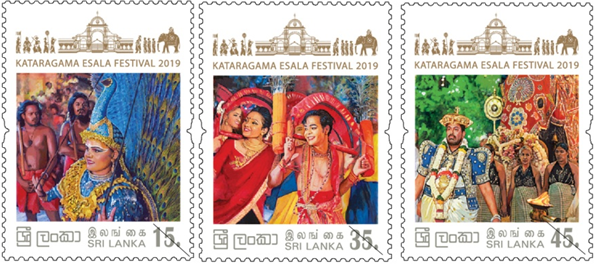
The Philatelic Bureau of the Department of Post has issued new postage stamps in the denominations of Rs. 15.00, Rs. 35.00 and Rs. 45.00 on 08 July 2019 to commemorate the Ruhunu Maha Katharagama Esala Perahera.
| Date of Issue | 08th of July 2019 |
| Denomination | Rs.15.00, Rs 35.00 , Rs.45.00 |
| Catalogue No: | Rs.15.00 - CSL 2328 Rs.35.00 - CSL 2329 Rs.45.00 - CSL 2330 |
| Stamp Designer | Sudath Jayawardane | Stamp Size: | 41mm x 30mm |
| Sheet Composition: | 20 stamps per sheet |
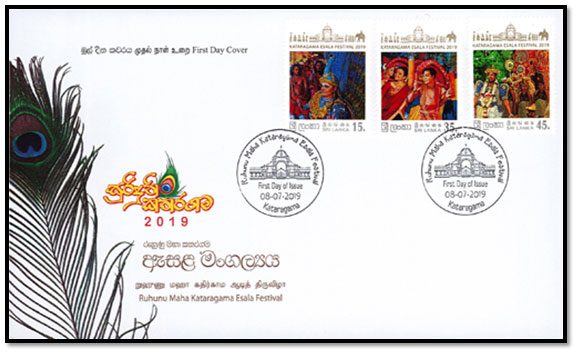
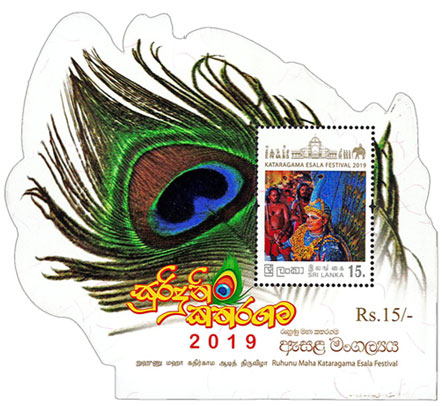
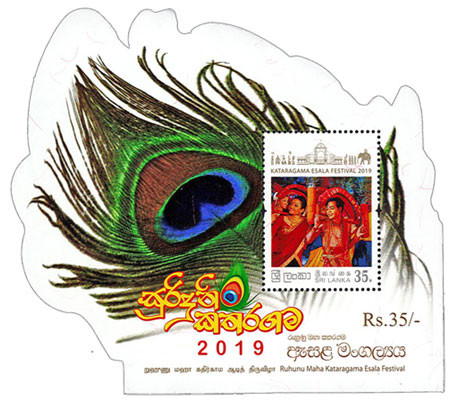
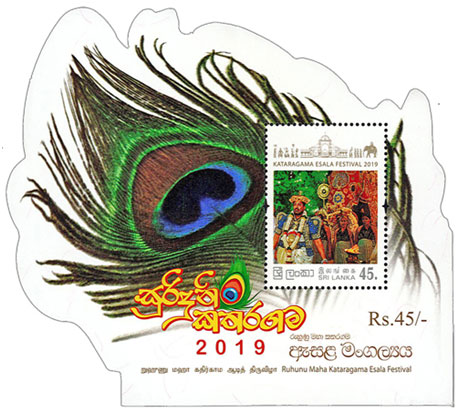
The Philatelic Bureau of the Department of Posts has been issued new postage stamps in the denominations of Rs. 15.00, Rs. 35.00 and Rs. 45.00 on 08 July 2019 to commemorate the Ruhunu Maha Katharagama Esala Perahera.
The peacock dance, Kavadi dance and carrying the image of the gods in procession, which are highlights of the Katharagama Esala celebration, are depicted in the postage stamps.
The month of July, also called the Esala month, is believed by the Sri Lankans to be the month dedicated to the deities. The Esala festival is celebrated in areas such as Katharagama, Kandy and Devinuwara during this month. The Maha Devale of Katharagama organizes three main processions called the Bak Maha Perahera, Esala Perahera and Il Maha Perahera.
The Bak Maha Perahera is organized in the month of April, the month in which Sinhala and Tamil New Year is celebrated. This procession is a one day procession.
Then comes the Kap Situwieme Perahera or the procession to commemorate the ceremony of planting the ‘Kap’ or the auspicious post. The Esala celebration takes a prominent place among the many annual religious ceremonies, offerings and processions taking place on the sacred grounds of Katharagama. This celebration which lasts almost 15 days, begin when the auspicious post or the “Kap” is planted. Consequently the Esala celebrations will begin and holding of 15 processions, walking on fire, water-cutting ceremony and other offerings made to deities will take place, giving priority to Buddhist teachings.
This age-old tradition of the Esala festival is still celebrated with great enthusiasm for fifteen days. The traditional belief is that the festival celebrates the joy of marriage between God Katharagama and his bride Walli Amma.
The planting of the auspicious post marks the beginning of the Esala celebration. Once the auspicious post is planted, an overnight pirith chanting will take place on the day prior to the commencement of the procession at the special pavilion created for this purpose at the monastery situated within the sacred land. This is another time-honored tradition performed under the auspices of the Basnayake Nilame to bless the procession that is to commence the next day. The main objective of this tradition is to garner the blessings of the gods to make the Perahera a success and to garner blessings for the citizens in the country. The annual Esala celebration and other offerings and rituals which have been continued on the sacred grounds of Katharagama from the time of the King Dutugemuni, come to a conclusion on the banks of the historic Manik river when the auspicious water cutting ceremony takes place at the Jeewamali river port.
The Palani Murugan Shrine in the Tamilnadu State of South India, is located on top of a high mountain. The worshipers used to tie their offerings to the gods on the two ends of a long stick and balance this stick on their shoulders as they climbed the hill to reach the shrine.
As time passed, the pilgrims would make a habit of decorating the stick with peacock feathers and they would balance it on their shoulders as they sang songs and danced while climbing up the hill. This dance became known as Kavadi Attam.
This is the origin of the Kavadi dance which is performed during the procession in honour of God Katharagama. This dance has become an essential part of the rituals performed on the sacred land of Katharagama.
The peacock dance is an adaptation of the Mail Attam dance, which is popular among South Indians and Tamils living in the Northern and Eastern parts of Sri Lanka. This is a novel dance that was incorporated into the Katharagama Perahera during the past two decades. The Naiandi Melan music used in the Kavadi dance is used in this dance. It is closely bound with the community to the point where it is considered a dance item of the Sinhala Buddhists.
(All rights received. All right to identify the Department of Posts as the Author and designer of this Bulleting has been asserted in accordance with the Copyright, Design and Patents Act 1988.No part to this publication may be reproduced, stored in or introduced into a retrieval system, or transmitted in any form or by and means (electronic, mechanical, photocopying, recording or otherwise) without the prior permission from the publisher. Any person who does and unauthorized act in relation to this publication may be liable to criminal prosecution and civil claims for damages.)